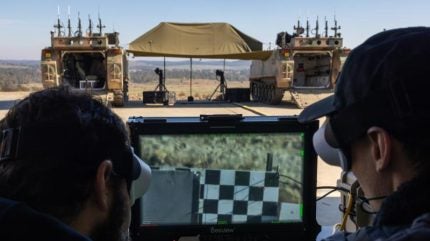
The Australian Defence Force (ADF) demonstrated a deployable prototype of its first Directed Energy Weapon (DEW), the Fractl Portable High Energy Laser, at the Puckapunyal range in May.
The DEW, which is capable of tracking objects “as small as a 10-cent piece” travelling at 100 km/h from distances as great as 1km, is part of ADF’s expansion of its counter-uncrewed aerial vehicle (UAV) arsenal.
A release from the Australian Ministry of Defence on 17 June 2024, emphasises the speed in training soldiers as operators using intuitive controls and sophisticated computer-aided tracking.
Corporal Patrick Flanagan stated that he was given an introduction to the system in roughly five-minutes before successfully using he system to engage with and destroy a drone, highlighting the versatility and precision of the targeting process: “With your index finger you can quickly change your aim between the drone’s video camera, centre mass or one of the propellers. It only takes seconds to knock out the camera and two or three seconds to disable the rotor.”
Fractl, built by Melbourne company AIM Defence, was demonstrated at a range of 500 metres against a drone at Puckapunyal, making a ‘hard kill’ with ‘less than the amount of power it takes to boil a kettle’, according to the MoD.
AIM Defense Co-founder Jessica Glenn indicated that the company’s focus is on expanding the effective range of the system, so that it can performa a ‘hard kill’ at 1km, and operate in a counter-sensor capacity at up to 1.5km.
DEW systems offer a silent tool with an unlimited magazine for countering UAS, with the capacity to outperform armoured crews in terms of resource efficiency, as highlighted by Robotic and Autonomous Systems Implementation and Coordination Office’s (RICO) Warrant Officer Class Two (WO2) Eli Lea.
Lea was present at the demonstration, where Fractl was operated side-by-side with armoured crews, and mentioned that the armoured crews used a high quantity of ammunition and hit the target at very close range, with “no margin for error.”
Confidence challenge remains for the DEW sector
The DEW sector will be encouraged by the performance of the Fractl in a short range scenario demonstration, but until DEW systems range increases, its main challenge to greater prominence will be the contest between resource efficiency and system confidence.
DEW offer brilliant resource efficiency, particularly in the counter-UAS roles, where low cost attritable payloads are delivered on mass. Conventional air defence missiles have a cost far in excess of modern drones, and the ease with which UAS are produced poses a challenge for maintaining a comparative level of air defences. With a laser-based C-UAS, the cost imbalance is flipped, with each fire of a DEW amounting to only a few dollars of energy.
However, DEW C-UAS are intended to appear as a part of a layered air-defence systems in conjunction with the longer-range, high cost missile based defences. A target coming in from a longer range should be detached and interdicted by longer range systems before they reach the narrower radius of DEW effectiveness. A commander seeking to make a resource efficient defence – one that does not employ missile defences – would require a supreme confidence in the DEW to interdict the target in the final moments of its time-to-target.
However, as Lea indicates, an air defence system with an unlimited magazine will still be a valuable capability in an environment where drone-strikes regularly out-tax the missile-base defence capacity: “The lessons from Ukraine are that drones are a genuine problem and if we don’t do anything about it, we’re going to get a rude awakening in the next fight.”



